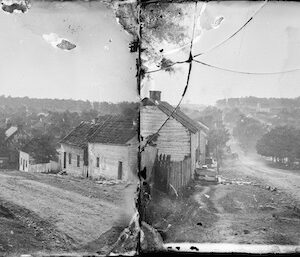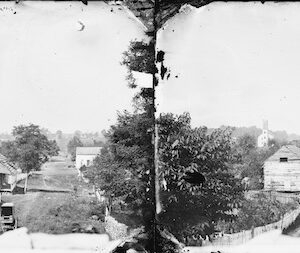Tag: Sharpsburg MD
Wikipedia says: Sharpsburg is a town in Washington County, Maryland, United States, located approximately 13 miles (21 km) south of Hagerstown.
During the American Civil War, the Battle of Antietam (or Battle of Sharpsburg) was fought on what is now Antietam National Battlefield, in the vicinity of Antietam Creek.
The first American of European descent to own land in what would eventually become Sharpsburg was the one-time indian trader Edmund Cartledge. By the time Cartledge surveyed his “Hickory Tavern[5]” land tract in 1737, the Great Philadelphia Wagon Road was already well established over the path that would become Sharpsburg’s main street. Hickory Tavern is noted in the patent as between the wagon road and Garrison Spring, today’s “Big Spring.” Thousands of immigrants used this route of the wagon road traveling from Pennsylvania as far south as the Carolinas. On May 1, 1755 the road was used by Major general Edward Braddock, colonial governor Horatio Sharpe and several of Braddock’s staff officers to reach Winchester, Virginia while his 48th regiment took a longer route via today’s Williamsport, Maryland. Among the officers accompanying Braddock that day was a young Virginia militia officer named George Washington. At the end of the French and Indian War in 1763, Joseph Chapline founded a town, naming it in honor of his friend Horatio Sharpe, the Proprietary Governor of the Province of Maryland. Its original settlers were mostly of German or Swiss origin reaching the area from Pennsylvania via the great wagon road. They were a major force in leading to an increase in wheat production from the original agricultural dependence on tobacco.
Located east of the Potomac River, Sharpsburg attracted industry in the early 19th century, especially after the Chesapeake and Ohio Canal was extended to Sharpsburg in 1836. The town was incorporated in 1832.
Sharpsburg gained national recognition during the American Civil War, when Confederate General Robert E. Lee invaded Maryland with his Army of Northern Virginia in the summer of 1862 and was intercepted near the city by Union General George B. McClellan with the Army of the Potomac. The rival armies met on September 17, in the Battle of Antietam (also called the Battle of Sharpsburg). It would be the bloodiest single day in all American military annals, with a total of nearly 23,000 casualties to both sides. A few days earlier, the multi-sited Battle of South Mountain occurred at the three low-lying passes in South Mountain—Crampton’s Gap, Turner’s Gap, and Fox’s Gap—where Lee’s forces attempted to hold back the advancing Union regiments moving westward especially along the important National Road (now U.S. Route 40 Alternate) which is now a part of South Mountain State Battlefield Park.
The drawn battle is considered a turning point of the war, since it kept the Confederacy from winning a needed victory on Northern soil, which might have gained it European recognition. Lee’s retreat gave Abraham Lincoln the opportunity he needed to issue his Emancipation Proclamation, declaring all slaves residing in rebelling Confederate territory against the federal government, to be free. This act made it even more unlikely that Europe would grant diplomatic recognition to the South.
Showing all 4 resultsSorted by latest



